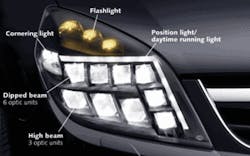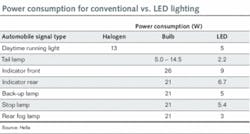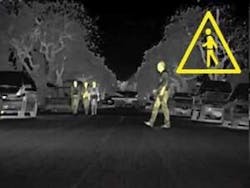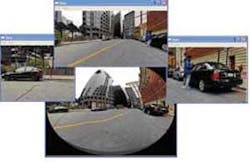PHOTONICS APPLIED: TRANSPORTATION: Auto industry is set to reap cost and performance benefits from photonics
Optics and photonics technologies offer auto makers an evolving “toolkit” of options to improve safety, lower long-term costs, improve efficiency, and add unique design elements to their vehicles. In addition to now commonplace light-emitting-diode (LED) taillights, some cars are sporting LED headlamps. Optical fiber is used to link communication and display devices. Ford is investigating an automotive laser ignition system. And some high-end autos offer night-vision and “driver assistance” systems.
LED taillights and headlamps
“Although the price for LED solutions in rear lamps and interior car illumination still is much higher than for incandescent-bulb signal functions, the advantages of the LED are great enough for automotive manufacturers to accept higher costs in development and manufacturing,” says Cornelius Neumann, professor for automotive lighting in the Lichttechnisches Institut (Lighting Institute) at Universität Karlsruhe (Karlsruhe, Germany). “Besides the long lifetime of an LED (it usually lasts longer than a car), the quick response time as a safety feature for brake lights (shortening the reaction time about 75 ms compared to bulbs), and the low power consumption, the new styling opportunities are the major reasons for applying LEDs in automotive signal functions.”
Neumann, who also spent 11 years in advanced development with automotive lighting and electronics supplier Hella (Lippstadt, Germany), says that although LED taillights are commonplace, LED headlamps present additional engineering challenges.
“So far, there are at least three cars with LED headlamps on the market: Lexus LS 600, Audi R8, and Cadillac Escalade Platinum,” says Neumann. “But there are many problems to solve for a full LED headlamp.”
Neumann notes that a hostile environment of dust, moisture, mechanical shocks, and surrounding temperature of roughly 90°C stresses LEDs, and because LEDs degrade with high temperature, cooling is required for high-power LED packages. In addition, instead of using a single light source—like halogen or high-intensity-discharge (HID) lamps—more than one LED package is needed to project enough illuminance on the road.1 Three different optical systems are typically used—one for the symmetric lower part, one for the asymmetric part, and another for the hot spot to illuminate the lane—requiring robust alignment of the systems to each other and for adequate projection on the road. Furthermore, the color of the LED light assembly should appear homogeneous, necessitating LED color binning.But despite these challenges, adds Neumann, LED signal functions can save 50% or more energy over bulb solutions (see table).2 New options for active lighting functions without mechatronics are available by using switchable LED arrays.3 And some studies are showing that 20% less LED light is needed to get the same perceived brightness as HID lamps—more safety with the same illuminance.4 And thanks to mathematical modeling and software algorithms, engineers are now in a position to generate free-form reflectors and lenses that direct the light generated from the light source into specific areas of the traffic space (see Fig. 1).
High-brightness LED manufacturers have every reason to be excited about the penetration of LEDs in the transportation sector: Strategies Unlimited (Mountain View, CA) forecasts the total automotive LED exterior-lighting market to grow from $158 million in 2008 to $347 million in 2013. The picture only improves by 2014 when, according to the Global and China Automotive LED Lighting Industry Report, 2008–2009 from ResearchInChina (Beijing, China), LED headlamps will be comparable in cost and performance to traditional HID headlamps (assuming LED technology keeps advancing at its current pace), with the market size for headlamps alone reaching $122 million.
Night vision
The second-generation Night Vision 2 System from Autoliv (Stockholm, Sweden) available on BMW-7 series vehicles uses a far-infrared (IR) sensor in the front grille to scan the road for pedestrians, seeing three times as far as the low-beam headlights. When a pedestrian or animal is detected, the system analyzes the scene and vehicle dynamics to assess the driver’s risk of hitting the object, and an alert is sent to the driver if necessary (via an in-vehicle display; see Fig. 2). “Autoliv’s latest system takes night driving to a whole new level of safety, providing drivers with ‘an extra set of eyes’ on the road at night,” says Stuart Klapper, Autoliv’s managing director of Night Vision Systems.At slower speeds in the city with higher pedestrian traffic, the system monitors a smaller and shorter portion of the road to prevent too many warnings, whereas in the countryside at higher speeds, the system monitors a wider and deeper stretch of road. To fine-tune the Autoliv system, night-vision video sequences were collected from around the world and more than 50 million “image patches” were used for training the advanced software algorithms to detect objects and alert the driver accordingly.
Autoliv’s far-IR camera is manufactured at its plant in Goleta, CA. The camera uses 320 × 240-element vanadium oxide bolometers with a 25 µm pitch and has a germanium window to protect the camera lens from rock strikes. “We have been successful in reducing the camera cost by 30% over our first-generation camera,” says Klapper.
Siemens VDO (Frankfurt, Germany) has also developed an IR night-vision system operational to 150 m that generates an electronically processed video image for real-time display in the vehicle. The system works in two ways: with the near-infrared system, the light produced by two IR emitters integrated into the headlights is captured by a small camera positioned close to the rear-view mirror; a second long-wave IR system uses a camera installed behind the radiator grille to detect the heat radiation from the vehicle’s surroundings using a sensor operating from 6 to 12 µm. Living things are displayed as bright objects.
Laser ignition
Ford made news this summer when it announced it was working with GSI Group (Rugby, England) and the University of Liverpool (Liverpool, England) to develop laser ignition system for next-generation car engines. The reality is that laser-initiated ignition systems have been in development since the late 1970s, when research papers on the subject began appearing at automotive technology conferences.
Because a laser can be split into multiple beams, those multiple ignition points improve the chance of a complete fuel burn in the engine, reducing emissions and improving efficiency in cold and damp conditions. A portion of the laser energy can even be reflected to provide information about how the engine is running, allowing air/fuel mixture adjustments to be made automatically for better fuel utilization. Ford also says that it plans to deliver the laser spark through a fiber-optic cable, which consumes less space than a spark plug and allows bigger and more-efficient engine valves for better combustion.
Researchers at The National Energy Technology Laboratory (www.netl.doe.gov) designed a laser-ignition system coupled with an internal combustion engine back in 2007. By focusing a 10 ns pulse from a 1.06 µm laser into the cylinder through the spark-plug port, an ignition spark is generated. Engine emissions were reduced and combustion was improved using the laser-spark system, compared to a conventional single-cylinder, four-stroke, spark-ignited natural gas engine.
Driver assistance systems
Beyond lighting and night vision, photonic-based “driver assistance” technologies are already available. A five-camera system from Valeo (Paris, France) for Land Rover and BMW-5 series vehicles includes a wide-angle camera installed in the rear of the car for parking assist, two cameras on the left and right of the front bumper to see approaching pedestrians or other objects when entering a street with poor visibility, and two additional cameras in the side-view mirrors to monitor the area directly beside the vehicle.
Panomorph is a patented wide-angle lens technology (different from fish-eye or catadioptric mirror lenses) from ImmerVision (Montreal, QC, Canada) that creates an elliptical rather than circular footprint on an image sensor, gaining 33% more resolution on a 4:3 ratio sensor (anamorphic ratio of 1.33) and 55% on a 16:9 ratio sensor (anamorphic ratio 1.55). Panamorph increases angular resolution in specific areas of the field of view of an image, with areas of interest targeted in the center or periphery of an image (see Fig. 3).5 Immersive viewing algorithms and image-processing functions allow multiple simultaneous views, conversion of geo-pixel coordinates into geo-spatial x, y, z coordinates, and sensor fusion. Specific virtual windows can be used for viewing, while other simultaneous views can be analyzed, for example, by an intelligent cruise-control system, allowing integration of many applications such as collision avoidance, dead-zone viewing, pedestrian and road-sign detection, and lane tracking.“Samsung signed a production and distribution license agreement with ImmerVision and is the first Automotive Tier 2 to offer a Panomorph automotive vision module,” said Alain Marchildon, vice president of custom panoramic applications at ImmerVision. “360-degree panoramic vision systems can enable new enhanced panoramic viewing and sensing applications, giving us safer highways by significantly reducing collision-related casualties.”
REFERENCES
- M. Kleinkes et al., Int’l. Symposium on Automotive Lighting (ISAL) 2007, Darmstadt, Germany (Sept. 25-26, 2007).
- M. Kleinkes and D. Decker, SAE 2009 World Congress, paper 2009-01-0057, Detroit, MI (April 20, 2009).
- C. Bangermann, Auto, Motor und Sport 18, p. 62 (2009).
- F. Kley et al., Licht 7/8, p. 562 (2007).
- S. Thibault et al., SPIE Defense, Security + Sensing 2009, paper 7314-08, Orlando, FL (April 13, 2009).
Physiological advantages of LEDs
In addition to lower energy consumption and design flexibility, LEDs offer a safety advantage to drivers for purely physiological reasons. The higher color temperature compared to halogen and xenon systems and the higher blue-light share are two unique features of LED headlamps that lead to improved human perception during twilight and darkness, according to recent studies.4 Because the sensitivity of the human eye depends on the wavelength of the radiation to be perceived and the adaptation state of the eye, the impression of brightness is greatly influenced by the spectral distribution of the light source. As the eye increasingly adapts to darkness, its sensitivity curve is displaced to shorter wavelengths with a maximum in the blue wavelength range (Purkinje effect); hence, the blue constituent of LED illumination improves driver vision in low-light conditions.
Also, peripheral vision is extremely important in road-traffic situations. Peripheral vision is dominated by the placement of rod-shaped receptors on the retina. Because rods have maximum sensitivity in the blue wavelength range, the high blue share of LEDs leads to higher sensitivity to potentially hazardous objects appearing in the lateral field of vision.

Gail Overton | Senior Editor (2004-2020)
Gail has more than 30 years of engineering, marketing, product management, and editorial experience in the photonics and optical communications industry. Before joining the staff at Laser Focus World in 2004, she held many product management and product marketing roles in the fiber-optics industry, most notably at Hughes (El Segundo, CA), GTE Labs (Waltham, MA), Corning (Corning, NY), Photon Kinetics (Beaverton, OR), and Newport Corporation (Irvine, CA). During her marketing career, Gail published articles in WDM Solutions and Sensors magazine and traveled internationally to conduct product and sales training. Gail received her BS degree in physics, with an emphasis in optics, from San Diego State University in San Diego, CA in May 1986.



